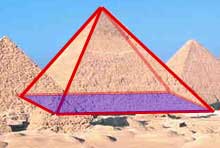Pyramids


When we think of pyramids we think of the Great Pyramids of Egypt.
They are actually Square Pyramids, because their base is a Square.
Parts of a Pyramid
A pyramid is made by connecting a base to an apex
The base is a polygon (flat with straight edges) and all other faces are triangles. No curves!
Types of Pyramids
There are many types of Pyramids, and they are named after the shape of their base.
| Pyramid | Base | |
| Triangular Pyramid: |
||
|---|---|---|
| Square Pyramid: |
||
| Pentagonal Pyramid: |
||
... and so on ... |
||
Fly through some pyramids here.
Right vs Oblique Pyramid
This tells us where the top (apex) of the pyramid is. When the apex is directly above the center of the base it is a Right Pyramid, otherwise it is an Oblique Pyramid.
| Right Pyramid | Oblique Pyramid |
|---|
Regular vs Irregular Pyramid
This tells us about the shape of the base. When the base is a regular polygon it is a Regular Pyramid, otherwise it is an Irregular Pyramid.
Regular Pyramid
Base is Regular
Irregular Pyramid
Base is Irregular
Area and Volume
The Volume of a Pyramid
Volume = 1 3 × [Base Area] × height
The Surface Area of a Pyramid
When all side faces are the same:
- [Base Area] + 12 × Perimeter × [Slant Length]
When side faces are different:
- [Base Area] + [Lateral Area]
Notes On Surface Area
The Surface Area has two parts: the area of the base (the Base Area), and the area of the side faces (the Lateral Area).
For Base Area :
It depends on the shape, there are different formulas for triangle, square, etc. See Area for formulas, or our Area Calculation Tool
For Lateral Area :
When all the side faces are the same:
- Multiply the perimeter by the "slant length" and divide by 2. This is because the side faces are always triangles and the triangle formula is "base times height divided by 2"
But when the side faces are different (such as an "irregular" pyramid) we must add up the area of each triangle to find the total lateral area.